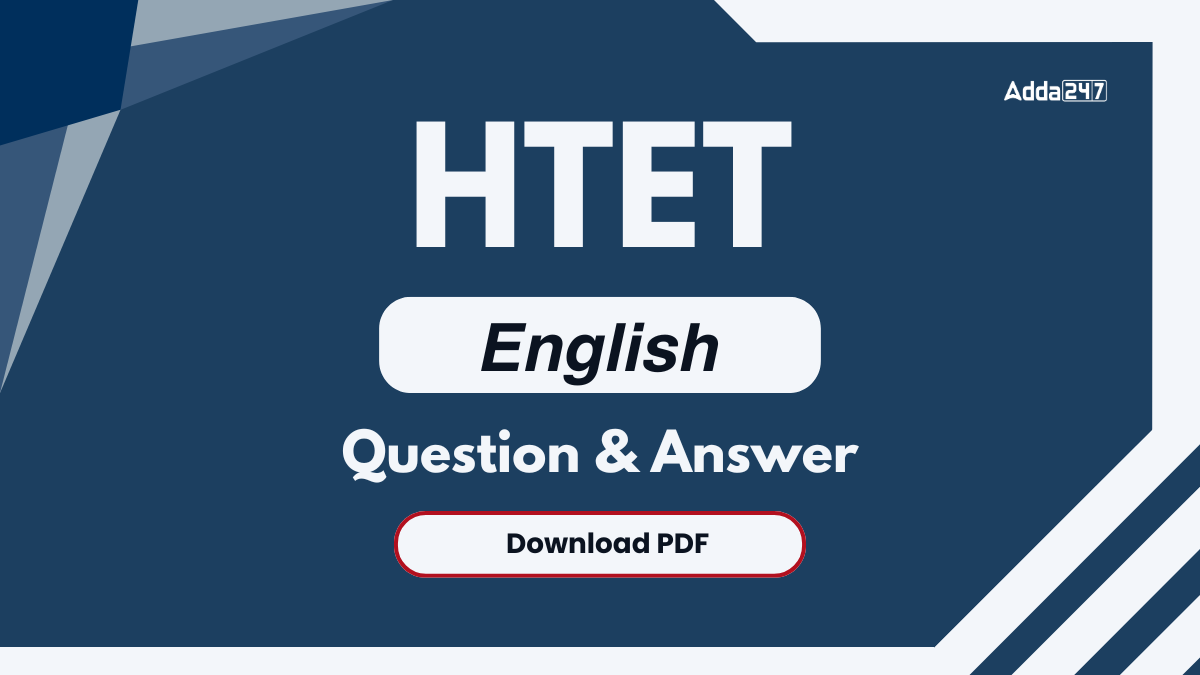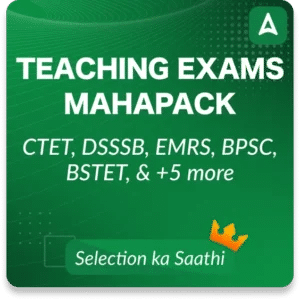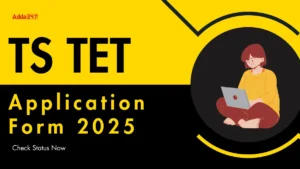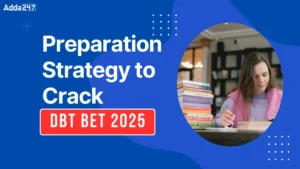Table of Contents
The HTET 2024 (Haryana Teacher Eligibility Test) is a prestigious state-level exam conducted by the Board of School Education, Haryana (BSEH). Scheduled for 7th and 8th December 2024, this examination is a gateway for candidates aspiring to secure teaching positions in Haryana schools, including Primary Teachers (PRT), Trained Graduate Teachers (TGT), and Post Graduate Teachers (PGT). The test is structured into three levels: Level-1 for PRT (classes I to V), Level-2 for TGT (classes VI to VIII), and Level-3 for PGT (classes IX to XII).
Each level evaluates the candidate’s teaching aptitude, subject knowledge, and understanding of child development. To ensure success, aspirants must stay updated with the latest official notifications, exam patterns, and syllabus guidelines. Thorough preparation and timely updates are key to excelling in this critical examination and achieving their teaching career goals.
HTET English Question and Answer
To excel in the HTET 2024, candidates must focus on the English section, as it is a significant component across all levels of the exam. This section evaluates a candidate’s proficiency in grammar, vocabulary, comprehension, and language usage. Key topics include error detection, sentence improvement, active-passive voice, direct and indirect speech, and passage-based questions, which require a thorough understanding of language rules and context.
Regular practice with previous years’ question papers, sample tests, and mock exams can help candidates gain familiarity with the pattern and improve their accuracy and time management. A solid grasp of English concepts not only aids in securing good marks but also enhances overall performance in the HTET exam. To assist candidates in preparation, we have provided free English questions and answers with detailed explanations for practice.
HTET English Question: Overview
The HTET 2024 (Haryana Teacher Eligibility Test), conducted by the Board of School Education, Haryana (BSEH), is a state-level examination scheduled for 7th and 8th December 2024. Held annually, the exam will be conducted offline in a pen-and-paper format with a duration of 2 hours and 30 minutes. It comprises a total of 150 multiple-choice questions (MCQs), carrying 150 marks, with 1 mark awarded for each correct response and no negative marking. The question paper will be available in bilingual format (English and Hindi), ensuring accessibility for a wider range of candidates.
The primary objective of HTET 2024 is to evaluate the eligibility of aspiring candidates for teaching positions in Haryana government schools, including Primary Teachers (PRT) for classes I to V, Trained Graduate Teachers (TGT) for classes VI to VIII, and Post Graduate Teachers (PGT) for classes IX to XII. This examination serves as a crucial step for individuals aiming to build a career in teaching within the state.
| HTET Exam Date 2024 | |
| Exam Name | Haryana State Teacher Eligibility Test (HTET ) |
| Conducting Body | Board of School Education, Haryana (BSEH) |
| Exam Level | State-level |
| Exam Frequency | Once in a year |
| Exam Mode | Conventional (pen and paper) |
| Exam Duration | Two and a half hours |
| Total Marks | 150 Marks (30 Marks dedicated to English Section) |
| Total Questions | 150 Questions (30 Questions dedicated to English Section) |
| Language | Bilingual ( English and Hindi) |
| Exam Purpose | To offer eligibility to teaching aspirants for Primary Teachers (PRT), Trained Graduate Teachers (TGT), and Post Graduate Teachers (PGT) in Government Schools in Haryana |
HTET English Questions and Answers
Q1. A cold-blooded murder
(a) An intentional /premeditated murder
(b) To go on a vacation
(c) To murder all members of a family
(d) To murder with no weapon
Q2. Put the best foot forward
(a) Get into
(b) Start impressively
(c) To give a sign of distress trouble
(d) Oppressively
Q3. Pay lip service to
(a) To make every possible effort
(b) Fight fiercely
(c) Pretend to express loyalty or support
(d) Very close
Q4. Stick one’s neck out
(a) To take a risk
(b) Completely
(c) To be cringe
(d) To be violent
Q5. Bear the palm
(a) To bear pain
(b) Be victorious
(c) To lose the game
(d) To control anger
Q6. Tread upon other’s toe
(a) To annoy somebody
(b) To kill somebody
(c) Hurt one’s feelings
(d) To praise somebody
Q7. Cock of the walk
(a) One who is the most stupid in a group
(b) One who dominates a group or situation
(c) One who enjoys the walk
(d) An additional achievement
Q8. From the horse’s mouth
(a) From a reliable source
(b) From an illegal source
(c) From a costly source
(d) From an unreliable source
Q9. A black ox
(a) To be lucky
(b) To have an ox
(c) Misfortune
(d) To misbehave
Q10. Fool’s errand
(a) Useless undertaking
(b) A fool’s house
(c) Literary person
(d) Intense Dislike
Directions (11-20): In the following questions, a sentence has been given in Active or Passive Voice. Out of the four alternatives suggested, select the one which best expresses the same sentence in Passive or Active Voice.
Q11. Mrs. Vaijanthi teaches us literature.
(a) We have been taught literature by Mrs. Vaijanthi.
(b) Literature is being taught by Mrs. Vaijanthi to us.
(c) Literature is being taught to us by Mrs. Vaijanthi.
(d) Literature is taught by Mrs. Vaijanthi to us.
Q12. I saw the master conducting the orchestra.
(a) I saw that the orchestra was being conducted by the master.
(b) I saw the orchestra being conducted by the master.
(c) The master was seen conducting the orchestra.
(d) The master was conducting the orchestra and I saw that.
Q13. Dark clouds have overcast the evening sky.
(a) By the dark clouds the evening sky was overcast.
(b) The evening sky has been overcast by the dark clouds.
(c) Dark clouds over casted the evening sky.
(d) The sky of the evening was over casted by dark clouds.
Q14. The Marathas surrendered their fort to the Mughals after the war.
(a) After the war, the Marathas had to surrender their fort to the Mughals.
(b) The Mughals after the war took the fort surrendered by the Marathas.
(c) Their fort was surrendered by the Marathas to the Mughals after the war.
(d) The Marathas after the war surrendered their fort to the Mughals.
Q15. Do you intimidate your younger brothers?
(a) Were your younger brothers being intimidated by you?
(b) Are your younger brothers intimidated by you?
(c) Have your younger brothers being intimidated by you?
(d) Are your younger brothers being intimidated by you?
Q16. Someone gave the old man a push.
(a) The old man got a push from someone.
(b) Somebody had given a push to the old man.
(c) The old man was being pushed by someone.
(d) A push was given to the old man.
Q17. Have the car stolen!
(a) Steal the car.
(b) You should have the stolen car.
(c) Get someone to steal the car.
(d) They have stolen the car.
Q18. Sunny was driving the car so fast that it slipped at the turn.
(a) Sunny slipped at the turn as he was driving the car so fast.
(b) So fast was Sunny driving the car that it slipped at the turn.
(c) The car was being driven by Sunny so fast that it slipped at the turn.
(d) The car slipped at the turn as Sunny was driving it so fast.
Q19. Mother filled dark filtered coffee in the cup.
(a) The cup was filled with dark filtered coffee by mother.
(b) Mother filled in the cup coffee which was dark and filtered.
(c) The cup was being filled by mother with dark filtered coffee.
(d) The filtered coffee which was dark was filled into the cup by mother.
Q20. Abhinav Bindra won the gold medal at the 2008 Beijing Olympic Games.
(a) Gold medal was won by Abhinav Bindra at the 2008 Beijing Olympic Games.
(b) In 2008 at the Beijing Olympics games Abhinav Bindra had won the gold medal.
(c) At the 2008 Beijing Olympics Games Abhinav Bindra won the gold medal.
(d) Abhinav Bindra must have won at the Beijing Olympics Games which were conducted in 2008.
Solutions for HTET English Questions
S1. Ans. (a) An intentional/premeditated murder
Sol. A “cold-blooded murder” refers to a murder committed with deliberate intent, without emotional agitation or spontaneity. It signifies calculated planning rather than being impulsive or accidental. The term underscores the absence of emotions like guilt or passion, reflecting a detached and ruthless mindset.
S2. Ans. (b) Start impressively
Sol. “Put the best foot forward” means to make the best impression possible, often in a new situation. This phrase emphasizes starting something, like a job or relationship, with confidence and competence to gain a favorable outcome.
S3. Ans. (c) Pretend to express loyalty or support
Sol. To “pay lip service” means to express verbal agreement or support for something without genuinely committing to it. It suggests insincerity or superficiality in one’s statements.
S4. Ans. (a) To take a risk
Sol. “Stick one’s neck out” means to take a bold risk, often putting oneself in a vulnerable position to achieve something or to support a cause or person.
S5. Ans. (b) Be victorious
Sol. “Bear the palm” is an idiomatic expression meaning to achieve victory or to be recognized as the best. The phrase originates from ancient traditions where victors were awarded palm branches.
S6. Ans. (c)
Sol. “Tread upon other’s toe” refers to inadvertently hurting someone’s feelings or offending them through words or actions. This idiom signifies causing emotional discomfort, often unintentionally, by encroaching on someone’s personal space, dignity, or beliefs.
S7. Ans. (b) One who dominates a group or situation
Sol. “Cock of the walk” refers to someone who is overly confident or dominant in a particular setting, often acting superior or boastful.
S8. Ans. (a) From a reliable source
Sol. “From the horse’s mouth” means obtaining information directly from a trustworthy or authoritative source, ensuring its authenticity.
S9. Ans. (c) Misfortune
Sol. “A black ox” symbolizes misfortune or adversity. This expression is often associated with bad luck or a streak of unfortunate events.
S10. Ans. (a) Useless undertaking
Sol. A “fool’s errand” refers to a pointless or futile task, often one that someone is sent on as a prank or due to misjudgment. It implies wasted effort.
S11. Ans.(d)
Sol. Active Voice: In Active voice the subject is the one doing the action.
Passive Voice: In Passive voice the subject is the recipient of the action.
To convert active voice into passive voice the object becomes the subject and the subject becomes the object. Subject + verb + object 🡨🡪Object+3rd form of verb + by +Subject.
In Simple Present Tense as presented in the question the structure for changing tense into active/passive is
Subject + is/am/are + V1 + Object🡨🡪 Object + is/am/are+ V3+ by Subject
For Example- Active- I do not complete the work on time.
Passive- The work is not completed on time by me.
S12. Ans. (b)
Sol. Active Voice: In Active voice the subject is the one doing the action.
Passive Voice: In Passive voice the subject is the recipient of the action.
To convert active voice into passive voice the object becomes the subject and the subject becomes the object. Subject + verb + object 🡨🡪Object+3rd form of verb + by +Subject.
In Past Continuous Tense as presented in the question the structure for changing tense into active to passive and vice versa is
Subject + was/were + v1+ing+ object 🡨🡪 Object+ was/were +being+V3+ by + subject
For Example- Active- I was not doing the work on time.
Passive- The work was not being done on time by me.
S13. Ans. (b)
Sol. Active Voice: In Active voice the subject is the one doing the action.
Passive Voice: In Passive voice the subject is the recipient of the action.
To convert active voice into passive voice the object becomes the subject and the subject becomes the object. Subject + verb + object 🡨🡪Object+3rd form of verb + by +Subject.
In Present Perfect Tense as presented in the question the structure for changing tense into active to passive and vice versa is
Subject + has/have+ v3+ object🡨🡪 Object+ has/have+ been+ V3+ by + subject.
For Example- Active- He has completed a lap.
Passive- A lap has been completed by him.
S14. Ans. (c)
Sol. Active Voice: In Active voice the subject is the one doing the action.
Passive Voice: In Passive voice the subject is the recipient of the action.
To convert active voice into passive voice the object becomes the subject and the subject becomes the object. Subject + verb + object 🡨🡪Object+3rd form of verb + by +Subject.
In Simple Past Tense as presented in the question the structure for changing tense into active to passive and vice versa is
Subject + V2+ object 🡨🡪 Object+ was/were + V3+ by + subject.
For Example- Active- I did yoga.
Passive- Yoga was done by me.
S15. Ans. (b)
Sol. Active Voice: In Active voice the subject is the one doing the action.
Passive Voice: In Passive voice the subject is the recipient of the action.
To convert active voice into passive voice the object becomes the subject and the subject becomes the object. Subject + verb + object 🡨🡪Object+3rd form of verb + by +Subject.
In Simple Present Tense as presented in the question the structure for changing tense into active/passive is
Do/Does+ Subject+ V1+Object+? 🡨🡪Is/am/are + Object+ V3+ by subject +?
For Example- Active- Do you paint cars?
Passive- Are cars painted by you?
S16. Ans. (d)
Sol. Active Voice: In Active voice the subject is the one doing the action.
Passive Voice: In Passive voice the subject is the recipient of the action.
To convert active voice into passive voice the object becomes the subject and the subject becomes the object. Subject + verb + object 🡨🡪Object+3rd form of verb + by +Subject.
In Simple Past Tense as presented in the question the structure for changing tense into active to passive and vice versa is
Subject + V2+ object 🡨🡪 Object+ was/were + V3+ by + subject.
For Example- Active- I did yoga.
Passive- Yoga was done by me.
S17. Ans. (c)
Sol. Active Voice: In Active voice the subject is the one doing the action.
Passive Voice: In Passive voice the subject is the recipient of the action.
To convert active voice into passive voice the object becomes the subject and the subject becomes the object. Subject + verb + object 🡨🡪Object+3rd form of verb + by +Subject.
Many times, we notice that who has completed the work is not mentioned in passive voice.
When we change the passive voice into the active voice, we have to mention the subject. But there is no particular rule to selecting the subject. We can use one, someone, people, they, circumstance, and so on as a subject depending on the situation.
If someone gives a command, requests, expresses or desires a wish the sentence is called an Imperative sentence.
“Get someone to steal the car.” is the most appropriate option out of the four.
S18. Ans. (c)
Sol. Active Voice: In Active voice the subject is the one doing the action.
Passive Voice: In Passive voice the subject is the recipient of the action.
To convert active voice into passive voice the object becomes the subject and the subject becomes the object. Subject + verb + object 🡨🡪Object+3rd form of verb + by +Subject.
In Past Continuous Tense as presented in the question the structure for changing tense into active to passive and vice versa is
Subject + was/were + v1+ing+ object 🡨🡪 Object+ was/were +being+V3+ by + subject
For Example- Active- I was not doing the work on time.
Passive- The work was not being done on time by me.
S19. Ans. (a)
Sol. Active Voice: In Active voice the subject is the one doing the action.
Passive Voice: In Passive voice the subject is the recipient of the action.
To convert active voice into passive voice the object becomes the subject and the subject becomes the object. Subject + verb + object 🡨🡪Object+3rd form of verb + by +Subject.
In Simple Past Tense as presented in the question the structure for changing tense into active to passive and vice versa is
Subject + V2+ object 🡨🡪 Object+ was/were + V3+ by + subject.
For Example- Active- I did yoga.
Passive- Yoga was done by me.
S20. Ans. (a)
Sol. Active Voice: In Active voice the subject is the one doing the action.
Passive Voice: In Passive voice the subject is the recipient of the action.
To convert active voice into passive voice the object becomes the subject and the subject becomes the object. Subject + verb + object 🡨🡪Object+3rd form of verb + by +Subject.
In Simple Past Tense as presented in the question the structure for changing tense into active to passive and vice versa is
Subject + V2+ object 🡨🡪 Object+ was/were + V3+ by + subject.
Download the HTET English Questions and Answers PDF
Click the direct link to download the detailed HTET English Question and Answer PDF. This essential resource contains 30 HTET English questions and answers, covering both content and pedagogy, to help candidates strengthen their preparation.
| Download HTET English Questions and Answers PDF | |
| HTET English Questions and Answers PDF | Click Here to Download |




 Last Minute Preparation Tips for MP TET ...
Last Minute Preparation Tips for MP TET ...
 TS TET Application Form 2025 Out, Direct...
TS TET Application Form 2025 Out, Direct...
 Preparation Strategy to Crack DBT BET 20...
Preparation Strategy to Crack DBT BET 20...














